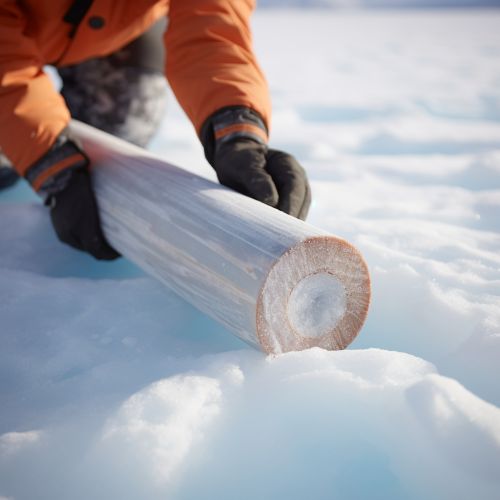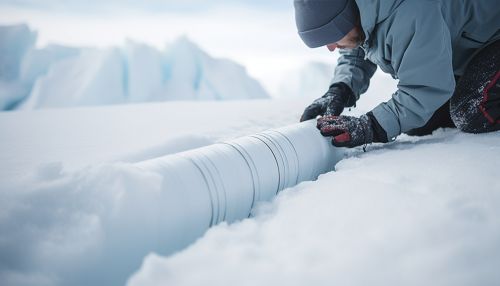Ice Core
Introduction
Ice cores are cylindrical samples of ice obtained from glaciers and ice sheets. They are an invaluable tool in paleoclimatology, the study of past climates. Ice cores provide a direct record of the past climate, and contain an abundance of information about our planet's climate history.


Formation of Ice Cores
Ice cores form as snow accumulates on the surface of glaciers or ice sheets. Over time, the snow compresses under its own weight and turns into firn, a granular type of snow that is in the process of compacting into glacier ice. As more snow falls and compresses the layers below, the firn eventually turns into solid ice. This process can take decades to centuries, depending on the local climate and snow accumulation rates.
Extraction of Ice Cores
The extraction of ice cores is a complex process that requires specialized equipment and expertise. The first step is to select a suitable site for drilling. This is typically done in areas where the ice is thickest and the accumulation rate is highest, to ensure a long and continuous record. Once a site is selected, a team of scientists and technicians drill into the ice using a hollow drill bit. The ice core is then carefully extracted from the hole and transported to a laboratory for analysis.
Analysis of Ice Cores
The analysis of ice cores involves a variety of techniques and methods. One of the most important is the measurement of the ratio of isotopes of oxygen and hydrogen in the ice. These ratios can tell scientists about the temperature at the time the ice was formed. Other analyses include the measurement of gases trapped in the ice, such as carbon dioxide and methane, which can provide information about past atmospheric composition and greenhouse gas concentrations.
In addition, ice cores can contain traces of volcanic ash, dust, pollen, and other particles that can provide information about past volcanic eruptions, wind patterns, vegetation, and other environmental conditions.
Importance of Ice Cores in Climate Research
Ice cores play a crucial role in our understanding of past climate change. They provide a direct record of atmospheric gases and temperatures, allowing scientists to reconstruct past climates with a high degree of accuracy. This information is crucial for understanding how our climate has changed in the past, and for predicting how it may change in the future.
Ice cores also provide a unique perspective on human history. For example, they can show when and how rapidly humans began to alter the composition of the atmosphere during the Industrial Revolution. This information is crucial for understanding the human impact on climate change.
Challenges and Limitations
While ice cores provide a wealth of information, there are also challenges and limitations associated with their use. One of the main challenges is the difficulty of extracting and analyzing the cores. This process is time-consuming, expensive, and requires specialized equipment and expertise.
In addition, while ice cores provide a direct record of past climates, they are not a perfect record. The ice can be disturbed by various processes, such as melting and refreezing, which can alter the original signal. Furthermore, the oldest ice cores only go back about 800,000 years, which limits our ability to study climate change over longer timescales.
Future Directions
Despite these challenges, the study of ice cores continues to be a vibrant field of research. New technologies and methods are being developed to extract and analyze ice cores, and to extend the ice core record further back in time. These advancements promise to further our understanding of past climates and improve our ability to predict future climate change.
